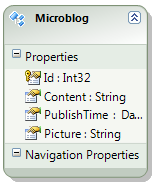我的WCF4 Rest Service及Entity Framework with POCO之旅(四)——定制Entity
来源:互联网 发布:adobe id是什么软件 编辑:程序博客网 时间:2024/06/05 20:56
http://www.cnblogs.com/Gildor/archive/2011/04/20/2022013.html
我的WCF4 Rest Service及Entity Framework with POCO之旅(四)——定制Entity
本文将focus几个结合使用WCF REST和Entity Framework with POCO的常见问题。
Entity Type和Property名称的大小写
按照RESTful的习惯,XML或者JSON格式的数据的node名称开头字母一般使用小写,比如,下面是一段Google Buzz API的RESTful返回信息:
<entry xmlns="http://www.w3.org/2005/Atom" xmlns:activity="http://activitystrea.ms/spec/1.0"> <id>tag:google.com,2010:buzz:z12puk22ajfyzsz</id> <author> <name>Ted Taco</name> <uri>http://www.google.com/profiles/ted</uri> </author> <published>2010-04-23T11:03:34.342Z</published> <updated>2010-04-23T11:03:34.342Z</updated> <activity:object> <activity:object-type>http://activitystrea.ms/schema/1.0/note</activity:object-type> <content type="html">Hey, this is my first Buzz Post!</content> <activity:object> <link rel="alternate" type="text/html" href="http://www.google.com/buzz/ted/Hey-this-is-my-first-Buzz-Post" /> <!-- more data --></entry>要让我们的Service返回数据node也使用小写字母开头,我们需要给Entity加上[DataContract]和[DataMember] attributes。(当然也可以修改WCF的behavior让它使用我们提供的的serializer但是现在框架既然还能满足需求,我还不想那么做。)
手动加attribute显然不是一个好主意,而且可以想见一旦模型代码重新生成,我们的修改就都没了。我们需要修改生成Entity的T4模板(Model.tt和Model.Context.tt)。
T4模板和其他的一些代码生成器的模板很相似,和现在的ASP.NET也有点相似。主要特点就是在模板内容(对于模板来说类似于纯文本)中嵌入C#代码。
由于T4模板的可读性不是很好,而VS原生又不支持T4的高亮和intellisense,开始编辑之前,最好装一个支持T4高亮的插件。我用的是Visual T4,虽然反应比较慢还有一些bug,不过是免费的,基本也够用了。
我们先看一下现在的Model.tt的全貌:
<#@ template language="C#" debug="false" hostspecific="true"#><#@ include file="EF.Utility.CS.ttinclude"#><#@ output extension=".cs"#><#CodeGenerationTools code = new CodeGenerationTools(this);MetadataLoader loader = new MetadataLoader(this);CodeRegion region = new CodeRegion(this, 1);MetadataTools ef = new MetadataTools(this);string inputFile = @"WcfRestServiceDemo.edmx";EdmItemCollection ItemCollection = loader.CreateEdmItemCollection(inputFile);string namespaceName = code.VsNamespaceSuggestion();EntityFrameworkTemplateFileManager fileManager = EntityFrameworkTemplateFileManager.Create(this);// Write out support code to primary template output fileWriteHeader(fileManager);BeginNamespace(namespaceName, code);WriteCustomObservableCollection();EndNamespace(namespaceName);// Emit Entity Typesforeach (EntityType entity in ItemCollection.GetItems<EntityType>().OrderBy(e => e.Name)){ fileManager.StartNewFile(entity.Name + ".cs"); BeginNamespace(namespaceName, code); bool entityHasNullableFKs = entity.NavigationProperties.Any(np => np.GetDependentProperties().Any(p=>ef.IsNullable(p)));#><#=Accessibility.ForType(entity)#> <#=code.SpaceAfter(code.AbstractOption(entity))#>partial class <#=code.Escape(entity)#><#=code.StringBefore(" : ", code.Escape(entity.BaseType))#>{<# region.Begin("Primitive Properties"); foreach (EdmProperty edmProperty in entity.Properties.Where(p => p.TypeUsage.EdmType is PrimitiveType && p.DeclaringType == entity)) { bool isForeignKey = entity.NavigationProperties.Any(np=>np.GetDependentProperties().Contains(edmProperty)); bool isDefaultValueDefinedInModel = (edmProperty.DefaultValue != null); bool generateAutomaticProperty = false;#> <#=PropertyVirtualModifier(Accessibility.ForProperty(edmProperty))#> <#=code.Escape(edmProperty.TypeUsage)#> <#=code.Escape(edmProperty)#> {<# if (isForeignKey) {#> <#=code.SpaceAfter(Accessibility.ForGetter(edmProperty))#>get { return <#=code.FieldName(edmProperty)#>; } <#=code.SpaceAfter(Accessibility.ForSetter(edmProperty))#>set {<# if (entityHasNullableFKs) {#> try { _settingFK = true;<# PushIndent(CodeRegion.GetIndent(1)); } if (((PrimitiveType)edmProperty.TypeUsage.EdmType).PrimitiveTypeKind == PrimitiveTypeKind.Binary) {#> if (!StructuralComparisons.StructuralEqualityComparer.Equals(<#=code.FieldName(edmProperty)#>, value))<# } else {#> if (<#=code.FieldName(edmProperty)#> != value)<# }#> {<# foreach (var np in entity.NavigationProperties.Where(np=>np.GetDependentProperties().Contains(edmProperty))) { EdmProperty principalProperty = ef.GetCorrespondingPrincipalProperty(np, edmProperty); if (((PrimitiveType)principalProperty.TypeUsage.EdmType).PrimitiveTypeKind == PrimitiveTypeKind.Binary) {#> if ((<#=code.Escape(np)#> != null) && !StructuralComparisons.StructuralEqualityComparer.Equals(<#=code.Escape(np)#>.<#=code.Escape(principalProperty)#>, value))<# } else {#> if (<#=code.Escape(np)#> != null && <#=code.Escape(np)#>.<#=code.Escape(principalProperty)#> != value)<# }#> {<# if (!(np.GetDependentProperties().Where(p=>ef.IsNullable(p)).Any() && np.GetDependentProperties().Count() > 1)) {#> <#=code.Escape(np)#> = null;<# } else {#> var previousValue = <#=code.FieldName(np)#>; <#=code.FieldName(np)#> = null; Fixup<#=np.Name#>(previousValue, skipKeys: true);<# }#> }<# }#> <#=code.FieldName(edmProperty)#> = value; }<# if (entityHasNullableFKs) { PopIndent();#> } finally { _settingFK = false; }<# }#> }<# } else if (isDefaultValueDefinedInModel) {#> <#=code.SpaceAfter(Accessibility.ForGetter(edmProperty))#>get { return <#=code.FieldName(edmProperty)#>; } <#=code.SpaceAfter(Accessibility.ForSetter(edmProperty))#>set { <#=code.FieldName(edmProperty)#> = value; }<# } else { generateAutomaticProperty = true;#> <#=code.SpaceAfter(Accessibility.ForGetter(edmProperty))#>get; <#=code.SpaceAfter(Accessibility.ForSetter(edmProperty))#>set;<# }#> }<# if (!generateAutomaticProperty) {#> private <#=code.Escape(edmProperty.TypeUsage)#> <#=code.FieldName(edmProperty)#><#=code.StringBefore(" = ", code.CreateLiteral(edmProperty.DefaultValue))#>;<# } } region.End(); region.Begin("Complex Properties"); foreach(EdmProperty edmProperty in entity.Properties.Where(p => p.TypeUsage.EdmType is ComplexType && p.DeclaringType == entity)) {#> <#=PropertyVirtualModifier(Accessibility.ForProperty(edmProperty))#> <#=code.Escape(edmProperty.TypeUsage)#> <#=code.Escape(edmProperty)#> { <#=code.SpaceAfter(Accessibility.ForGetter(edmProperty))#>get { return <#=code.FieldName(edmProperty)#>; } <#=code.SpaceAfter(Accessibility.ForSetter(edmProperty))#>set { <#=code.FieldName(edmProperty)#> = value; } } private <#=code.Escape(edmProperty.TypeUsage)#> <#=code.FieldName(edmProperty)#> = new <#=code.Escape(edmProperty.TypeUsage)#>();<# } region.End(); //////// //////// Write Navigation properties ------------------------------------------------------------------------------------------- //////// region.Begin("Navigation Properties"); foreach (NavigationProperty navProperty in entity.NavigationProperties.Where(np => np.DeclaringType == entity)) { NavigationProperty inverse = ef.Inverse(navProperty); if (inverse != null && !IsReadWriteAccessibleProperty(inverse)) { inverse = null; }#><# if (navProperty.ToEndMember.RelationshipMultiplicity == RelationshipMultiplicity.Many) {#> <#=PropertyVirtualModifier(Accessibility.ForReadOnlyProperty(navProperty))#> ICollection<<#=code.Escape(navProperty.ToEndMember.GetEntityType())#>> <#=code.Escape(navProperty)#> { get { if (<#=code.FieldName(navProperty)#> == null) {<# if (inverse != null || ((AssociationType)navProperty.RelationshipType).IsForeignKey) {#> var newCollection = new FixupCollection<<#=code.Escape(navProperty.ToEndMember.GetEntityType())#>>(); newCollection.CollectionChanged += Fixup<#=navProperty.Name#>; <#=code.FieldName(navProperty)#> = newCollection;<# } else {#> <#=code.FieldName(navProperty)#> = new FixupCollection<<#=code.Escape(navProperty.ToEndMember.GetEntityType())#>>();<# }#> } return <#=code.FieldName(navProperty)#>; } set {<# if (inverse != null || ((AssociationType)navProperty.RelationshipType).IsForeignKey) {#> if (!ReferenceEquals(<#=code.FieldName(navProperty)#>, value)) { var previousValue = <#=code.FieldName(navProperty)#> as FixupCollection<<#=code.Escape(navProperty.ToEndMember.GetEntityType())#>>; if (previousValue != null) { previousValue.CollectionChanged -= Fixup<#=navProperty.Name#>; } <#=code.FieldName(navProperty)#> = value; var newValue = value as FixupCollection<<#=code.Escape(navProperty.ToEndMember.GetEntityType())#>>; if (newValue != null) { newValue.CollectionChanged += Fixup<#=navProperty.Name#>; } }<# } else {#> <#=code.FieldName(navProperty)#> = value;<# }#> } } private ICollection<<#=code.Escape(navProperty.ToEndMember.GetEntityType())#>> <#=code.FieldName(navProperty)#>;<# } else {#> <#=PropertyVirtualModifier(Accessibility.ForProperty(navProperty))#> <#=code.Escape(navProperty.ToEndMember.GetEntityType())#> <#=code.Escape(navProperty)#> {<# if (inverse != null || ((AssociationType)navProperty.RelationshipType).IsForeignKey) {#> <#=code.SpaceAfter(Accessibility.ForGetter(navProperty))#>get { return <#=code.FieldName(navProperty)#>; } <#=code.SpaceAfter(Accessibility.ForSetter(navProperty))#>set { if (!ReferenceEquals(<#=code.FieldName(navProperty)#>, value)) { var previousValue = <#=code.FieldName(navProperty)#>; <#=code.FieldName(navProperty)#> = value; Fixup<#=navProperty.Name#>(previousValue); } } } private <#=code.Escape(navProperty.ToEndMember.GetEntityType())#> <#=code.FieldName(navProperty)#>;<# } else {#> <#=code.SpaceAfter(Accessibility.ForGetter(navProperty))#>get; <#=code.SpaceAfter(Accessibility.ForSetter(navProperty))#>set; }<# } } } region.End(); region.Begin("Association Fixup"); if (entityHasNullableFKs) {#> private bool _settingFK = false;<# } foreach (NavigationProperty navProperty in entity.NavigationProperties.Where(np => np.DeclaringType == entity)) { NavigationProperty inverse = ef.Inverse(navProperty); if (inverse != null && !IsReadWriteAccessibleProperty(inverse)) { inverse = null; } if ( (inverse != null || ((AssociationType)navProperty.RelationshipType).IsForeignKey) && (navProperty.ToEndMember.RelationshipMultiplicity != RelationshipMultiplicity.Many) ) { var skipKeysArgument = (navProperty.GetDependentProperties().Where(p=>ef.IsNullable(p)).Any() && navProperty.GetDependentProperties().Count() > 1) ? ", bool skipKeys = false" : String.Empty;#> private void Fixup<#=navProperty.Name#>(<#=code.Escape(navProperty.ToEndMember.GetEntityType())#> previousValue<#= skipKeysArgument #>) {<# if (inverse != null) { if (inverse.ToEndMember.RelationshipMultiplicity == RelationshipMultiplicity.Many) {#> if (previousValue != null && previousValue.<#=code.Escape(inverse)#>.Contains(this)) { previousValue.<#=code.Escape(inverse)#>.Remove(this); }<# } else {#> if (previousValue != null && ReferenceEquals(previousValue.<#=code.Escape(inverse)#>, this)) { previousValue.<#=code.Escape(inverse)#> = null; }<# } if (inverse.ToEndMember.RelationshipMultiplicity == RelationshipMultiplicity.Many) {#> if (<#=code.Escape(navProperty)#> != null) { if (!<#=code.Escape(navProperty)#>.<#=code.Escape(inverse)#>.Contains(this)) { <#=code.Escape(navProperty)#>.<#=code.Escape(inverse)#>.Add(this); }<# foreach (var dependentProperty in navProperty.GetDependentProperties()) { EdmProperty principalProperty = ef.GetCorrespondingPrincipalProperty(navProperty, dependentProperty); if (((PrimitiveType)principalProperty.TypeUsage.EdmType).PrimitiveTypeKind == PrimitiveTypeKind.Binary) {#> if (!StructuralComparisons.StructuralEqualityComparer.Equals(<#=code.Escape(dependentProperty)#>, <#=code.Escape(navProperty)#>.<#=code.Escape(principalProperty)#>))<# } else {#> if (<#=code.Escape(dependentProperty)#> != <#=code.Escape(navProperty)#>.<#=code.Escape(principalProperty)#>)<# }#> { <#=code.Escape(dependentProperty)#> = <#=code.Escape(navProperty)#>.<#=code.Escape(principalProperty)#>; }<# }#> }<# if (navProperty.GetDependentProperties().Where(p=>ef.IsNullable(p)).Any()) { if (navProperty.GetDependentProperties().Count() > 1) {#> else if (!_settingFK && !skipKeys)<# } else {#> else if (!_settingFK)<# }#> {<# foreach (var dependentProperty in navProperty.GetDependentProperties().Where(p => ef.IsNullable(p))) {#> <#=code.Escape(dependentProperty)#> = null;<# }#> }<# } } else {#> if (<#=code.Escape(navProperty)#> != null) { <#=code.Escape(navProperty)#>.<#=code.Escape(inverse)#> = this;<# foreach (var dependentProperty in navProperty.GetDependentProperties()) { EdmProperty principalProperty = ef.GetCorrespondingPrincipalProperty(navProperty, dependentProperty); if (((PrimitiveType)principalProperty.TypeUsage.EdmType).PrimitiveTypeKind == PrimitiveTypeKind.Binary) {#> if (!StructuralComparisons.StructuralEqualityComparer.Equals(<#=code.Escape(dependentProperty)#>, <#=code.Escape(navProperty)#>.<#=code.Escape(principalProperty)#>))<# } else {#> if (<#=code.Escape(dependentProperty)#> != <#=code.Escape(navProperty)#>.<#=code.Escape(principalProperty)#>)<# }#> { <#=code.Escape(dependentProperty)#> = <#=code.Escape(navProperty)#>.<#=code.Escape(principalProperty)#>; }<# }#> }<# } } else { if (navProperty.GetDependentProperties().Any()) {#> if (<#=code.Escape(navProperty)#> != null) {<# foreach (var dependentProperty in navProperty.GetDependentProperties()) { EdmProperty principalProperty = ef.GetCorrespondingPrincipalProperty(navProperty, dependentProperty); if (((PrimitiveType)principalProperty.TypeUsage.EdmType).PrimitiveTypeKind == PrimitiveTypeKind.Binary) {#> if (!StructuralComparisons.StructuralEqualityComparer.Equals(<#=code.Escape(dependentProperty)#>, <#=code.Escape(navProperty)#>.<#=code.Escape(principalProperty)#>))<# } else {#> if (<#=code.Escape(dependentProperty)#> != <#=code.Escape(navProperty)#>.<#=code.Escape(principalProperty)#>)<# }#> { <#=code.Escape(dependentProperty)#> = <#=code.Escape(navProperty)#>.<#=code.Escape(principalProperty)#>; }<# }#> }<# if (navProperty.GetDependentProperties().Where(p => ef.IsNullable(p)).Any()) { if (navProperty.GetDependentProperties().Count() > 1) {#> else if (!_settingFK && !skipKeys)<# } else {#> else if (!_settingFK)<# }#> {<# foreach (var dependentProperty in navProperty.GetDependentProperties().Where(p => ef.IsNullable(p))) {#> <#=code.Escape(dependentProperty)#> = null;<# }#> }<# } } else if (((AssociationType)navProperty.RelationshipType).IsForeignKey) {#> if (<#=code.Escape(navProperty)#> != null) {<# foreach (var fromProperty in ef.GetPrincipalProperties(navProperty)) {#> <#=code.Escape(navProperty)#>.<#=code.Escape(ef.GetCorrespondingDependentProperty(navProperty, fromProperty))#> = <#=code.Escape(fromProperty)#>;<# }#> }<# } }#> }<# } } foreach (NavigationProperty navProperty in entity.NavigationProperties.Where(np => np.DeclaringType == entity)) { NavigationProperty inverse = ef.Inverse(navProperty); if (inverse != null && !IsReadWriteAccessibleProperty(inverse)) { inverse = null; } if ( (inverse != null || ((AssociationType)navProperty.RelationshipType).IsForeignKey) && (navProperty.ToEndMember.RelationshipMultiplicity == RelationshipMultiplicity.Many) ) {#> private void Fixup<#=navProperty.Name#>(object sender, NotifyCollectionChangedEventArgs e) { if (e.NewItems != null) { foreach (<#=code.Escape(navProperty.ToEndMember.GetEntityType())#> item in e.NewItems) {<# if (inverse != null) { if (inverse.ToEndMember.RelationshipMultiplicity != RelationshipMultiplicity.Many) {#> item.<#=code.Escape(inverse)#> = this;<# } else {#> if (!item.<#=code.Escape(inverse)#>.Contains(this)) { item.<#=code.Escape(inverse)#>.Add(this); }<# } } else if (((AssociationType)navProperty.RelationshipType).IsForeignKey) { foreach (var fromProperty in ef.GetPrincipalProperties(navProperty)) {#> item.<#=code.Escape(ef.GetCorrespondingDependentProperty(navProperty, fromProperty))#> = <#=code.Escape(fromProperty)#>;<# } }#> } } if (e.OldItems != null) { foreach (<#=code.Escape(navProperty.ToEndMember.GetEntityType())#> item in e.OldItems) {<# if (inverse != null) { if (inverse.ToEndMember.RelationshipMultiplicity != RelationshipMultiplicity.Many) {#> if (ReferenceEquals(item.<#=code.Escape(inverse)#>, this)) { item.<#=code.Escape(inverse)#> = null; }<# } else {#> if (item.<#=code.Escape(inverse)#>.Contains(this)) { item.<#=code.Escape(inverse)#>.Remove(this); }<# } } else if (((AssociationType)navProperty.RelationshipType).IsForeignKey) { foreach (var fromProperty in ef.GetPrincipalProperties(navProperty)) { var p = ef.GetCorrespondingDependentProperty(navProperty, fromProperty); if (ef.IsNullable(p.TypeUsage)) {#> item.<#=code.Escape(p)#> = null;<# } } };#> } } }<# } } region.End();#>}<# EndNamespace(namespaceName);}foreach (ComplexType complex in ItemCollection.GetItems<ComplexType>().OrderBy(e => e.Name)){ fileManager.StartNewFile(complex.Name + ".cs"); BeginNamespace(namespaceName, code);#><#=Accessibility.ForType(complex)#> partial class <#=code.Escape(complex)#>{<# region.Begin("Primitive Properties"); foreach(EdmProperty edmProperty in complex.Properties.Where(p => p.TypeUsage.EdmType is PrimitiveType && p.DeclaringType == complex)) { bool isDefaultValueDefinedInModel = (edmProperty.DefaultValue != null);#> <#=Accessibility.ForProperty(edmProperty)#> <#=code.Escape(edmProperty.TypeUsage)#> <#=code.Escape(edmProperty)#><# if (isDefaultValueDefinedInModel) {#> { <#=code.SpaceAfter(Accessibility.ForGetter(edmProperty))#>get { return <#=code.FieldName(edmProperty)#>; } <#=code.SpaceAfter(Accessibility.ForSetter(edmProperty))#>set { <#=code.FieldName(edmProperty)#> = value; } } private <#=code.Escape(edmProperty.TypeUsage)#> <#=code.FieldName(edmProperty)#><#=code.StringBefore(" = ", code.CreateLiteral(edmProperty.DefaultValue))#>;<# } else {#> { <#=code.SpaceAfter(Accessibility.ForGetter(edmProperty))#>get; <#=code.SpaceAfter(Accessibility.ForSetter(edmProperty))#>set; }<# } } region.End(); region.Begin("Complex Properties"); foreach(EdmProperty edmProperty in complex.Properties.Where(p => p.TypeUsage.EdmType is ComplexType && p.DeclaringType == complex)) {#> <#=Accessibility.ForProperty(edmProperty)#> <#=code.Escape(edmProperty.TypeUsage)#> <#=code.Escape(edmProperty)#> { <#=code.SpaceAfter(Accessibility.ForGetter(edmProperty))#>get { return <#=code.FieldName(edmProperty)#>; } <#=code.SpaceAfter(Accessibility.ForSetter(edmProperty))#>set { <#=code.FieldName(edmProperty)#> = value; } } private <#=code.Escape(edmProperty.TypeUsage)#> <#=code.FieldName(edmProperty)#> = new <#=code.Escape(edmProperty.TypeUsage)#>();<# } region.End();#>}<# EndNamespace(namespaceName);}if (!VerifyTypesAreCaseInsensitiveUnique(ItemCollection)){ return "";}fileManager.Process();#><#+void WriteHeader(EntityFrameworkTemplateFileManager fileManager, params string[] extraUsings){ fileManager.StartHeader();#>//------------------------------------------------------------------------------// <auto-generated>// This code was generated from a template.//// Changes to this file may cause incorrect behavior and will be lost if// the code is regenerated.// </auto-generated>//------------------------------------------------------------------------------using System;using System.Collections;using System.Collections.Generic;using System.Collections.ObjectModel;using System.Collections.Specialized;<#=String.Join(String.Empty, extraUsings.Select(u => "using " + u + ";" + Environment.NewLine).ToArray())#><#+ fileManager.EndBlock();}void BeginNamespace(string namespaceName, CodeGenerationTools code){ CodeRegion region = new CodeRegion(this); if (!String.IsNullOrEmpty(namespaceName)) {#>namespace <#=code.EscapeNamespace(namespaceName)#>{<#+ PushIndent(CodeRegion.GetIndent(1)); }}void EndNamespace(string namespaceName){ if (!String.IsNullOrEmpty(namespaceName)) { PopIndent();#>}<#+ }}bool IsReadWriteAccessibleProperty(EdmMember member){ string setter = Accessibility.ForWriteOnlyProperty(member); string getter = Accessibility.ForReadOnlyProperty(member); return getter != "private" && getter != "protected" && setter != "private" && setter != "protected";}string PropertyVirtualModifier(string accessibility){ return accessibility + (accessibility != "private" ? " virtual" : "");}void WriteCustomObservableCollection(){#>// An System.Collections.ObjectModel.ObservableCollection that raises// individual item removal notifications on clear and prevents adding duplicates.public class FixupCollection<T> : ObservableCollection<T>{ protected override void ClearItems() { new List<T>(this).ForEach(t => Remove(t)); } protected override void InsertItem(int index, T item) { if (!this.Contains(item)) { base.InsertItem(index, item); } }}<#+}bool VerifyTypesAreCaseInsensitiveUnique(EdmItemCollection itemCollection){ Dictionary<string, bool> alreadySeen = new Dictionary<string, bool>(StringComparer.OrdinalIgnoreCase); foreach(StructuralType type in itemCollection.GetItems<StructuralType>()) { if (!(type is EntityType || type is ComplexType)) { continue; } if (alreadySeen.ContainsKey(type.FullName)) { Error(String.Format(CultureInfo.CurrentCulture, "This template does not support types that differ only by case, the types {0} are not supported", type.FullName)); return false; } else { alreadySeen.Add(type.FullName, true); } } return true;}#>看起来很长?其实主要内容并不复杂。我们所要关心的的Entity生成代码都在一个遍历所有entity的foreach中,对于每个entity,它依次枚举Primitive Properties - entity本身定义的基本类型字段,Complex Properties - 用户定义的复杂类型字段,以及Navigation Properties - entity的关系字段。
首先找到生成每个类定义的代码:
<#=Accessibility.ForType(entity)#> <#=code.SpaceAfter(code.AbstractOption(entity))#>partial class <#=code.Escape(entity)#><#=code.StringBefore(" : ", code.Escape(entity.BaseType))#>在上面加一行:
[DataContract(Name = "<#=char.ToLowerInvariant(entity.Name[0]) + entity.Name.Substring(1) #>")]然后再找到生成Primitive Property的代码(其他的类似):
<#=PropertyVirtualModifier(Accessibility.ForProperty(edmProperty))#> <#=code.Escape(edmProperty.TypeUsage)#> <#=code.Escape(edmProperty)#>在上面加一行:
[DataMember(Name = "<#=char.ToLowerInvariant(edmProperty.Name[0]) + edmProperty.Name.Substring(1) #>")]由于DataContract在System.Runtime.Serialization命名空间下,我们还需要添加命名空间。在接近Model.tt末尾的地方找到有一堆命名空间定义,在末尾加上:
using System.Runtime.Serialization;然后Save,这时代码会重新生成,我们再看一下这时的Microblog.cs:
//------------------------------------------------------------------------------// <auto-generated>// This code was generated from a template.//// Changes to this file may cause incorrect behavior and will be lost if// the code is regenerated.// </auto-generated>//------------------------------------------------------------------------------using System;using System.Collections;using System.Collections.Generic;using System.Collections.ObjectModel;using System.Collections.Specialized;using System.Runtime.Serialization;namespace WcfRestServiceDemo.Data{ [DataContract(Name = "microblog")] public partial class Microblog { #region Primitive Properties [DataMember(Name = "id")] public virtual int Id { get; set; } [DataMember(Name = "content")] public virtual string Content { get; set; } [DataMember(Name = "publishTime")] public virtual System.DateTime PublishTime { get; set; } #endregion }}这时如果测试一下服务,就可以看到不论是XML还是JSON的返回结果中的字段都已经变成小写字母开头了。
需要注意的是,不仅是返回,这时客户端发送请求时,对应字段也必须同样改成小写字母开头。
处理Null值属性
为了引入这个问题,我们将服务稍稍变得复杂一些。假设现在并且每条微博可以关联一张图片,用户只要在写微博同时,输入图片地址即可。那么修改Microblog模型,添加Picture属性,包含一个图片的URL。由于图片是可选的,所以还要将的Nullable设为true。
如下:


由于修改了EntityModel,需要在两个.tt模板文件上右键选择Run Custom Tools来生成新的POCO entity.
然后我们看一下服务的返回:
<ArrayOfmicroblog xmlns="http://schemas.datacontract.org/2004/07/WcfRestServiceDemo.Data" xmlns:i="http://www.w3.org/2001/XMLSchema-instance"> <microblog> <content>Microblog with no picture.</content> <id>1</id> <picture i:nil="true"/> <publishTime>2011-04-19T22:00:00</publishTime> </microblog> <microblog> <content>Microblog with picture</content> <id>2</id> <picture>http://somepicture/somepicture</picture> <publishTime>2011-04-19T22:00:00</publishTime> </microblog></ArrayOfmicroblog>这里有两条microblog,一条有picture,一条没有。但是没有picture的那个也把picture字段给返回了,只是用i:nil=”true”来标识这是个null值。显然这不是理想方式,想象一下一个entity可能会有很多可空的属性,尤其是当一个entity与许多其他entity产生关联,引入了许多navigation properties时,传输这些空属性将严重影响可读性(虽然大多数情况下应该不是人来读)并对性能造成影响(传输、序列化和反序列化)。(当然这不是绝对的,nil值有其应用场景,请根据实际情况决定)
幸好DataMember attribute还有一个EmitDefaultValue属性,可以指定是否要序列化默认值。用和刚才类似的方法,修改T4模板,修改Property定义上方的[DataMember]:
[DataMember(Name = "<#=char.ToLowerInvariant(edmProperty.Name[0]) + edmProperty.Name.Substring(1) #>"<#if(edmProperty.Nullable){#>, EmitDefaultValue = false<#}#>)]首先判断了property是否可设为null,若可以才省略空值。否则对于一个int属性,值为0时它就不会被传输了,这一般是不太合适的。(确切的讲,这里的Nullable和数据类型没有关系,指的是在数据模型中的nullable,也就是是否为可空字段。)再次访问服务:
<ArrayOfmicroblog xmlns="http://schemas.datacontract.org/2004/07/WcfRestServiceDemo.Data" xmlns:i="http://www.w3.org/2001/XMLSchema-instance"> <microblog> <content>Microblog with no picture.</content> <id>1</id> <publishTime>2011-04-19T22:00:00</publishTime> </microblog> <microblog> <content>Microblog with picture</content> <id>2</id> <picture>http://somepicture/somepicture</picture> <publishTime>2011-04-19T22:00:00</publishTime> </microblog></ArrayOfmicroblog>可以看到没有图片的那个microblog的picture属性已经被省略了。
JSON中的DateTime
在第二章末尾我们提到过DateTime属性在JSON表示下的奇怪格式。严格来说,这不算什么问题,因为既然微软选择了这种格式,那么全世界的人都在碰到这个问题,相应的客户端解决方案也有很多。比如:
- http://archive.cnblogs.com/a/1444633/
- http://stackoverflow.com/questions/206384/how-to-format-json-date
如果一定要从服务端解决这个问题的话,最根本的方法是改用自定义的序列化器。而比较简单的方法是为entity写一个partial类,然后提供一个long格式的对应属性:
using System;using System.Runtime.Serialization;namespace WcfRestServiceDemo.Data{ partial class Microblog { private static readonly DateTime _baseTime = new DateTime(1970, 1, 1, 0, 0, 0, DateTimeKind.Utc).ToLocalTime(); [DataMember(Name = "publishTimeSec")] public long PublishTimeSeconds { get { return (long)(PublishTime - _baseTime).TotalMilliseconds; } set { PublishTime = _baseTime.AddMilliseconds(value); } } }}这时服务的返回就是:
[ { "content":"Microblog with no picture.", "id":1, "publishTime":"\/Date(1303221600000+0800)\/", "publishTimeSec":1303221600000 }, { "content":"Microblog with picture", "id":2, "picture":"http:\/\/somepicture\/somepicture", "publishTime":"\/Date(1303221600000+0800)\/", "publishTimeSec":1303221600000 }]当然更绝的做法是把这个替代属性的生成也交给T4模板来做。具体做法请参考我整理好后上传的代码。
小结
本文介绍了:
- 如何修改T4模板控制模型代码的生成,包括修改Type名称、属性名称的起始字母大小写和是否要序列化默认值的选项
- 如何用替代属性解决JSON中DateTime格式的问题。
- 我的WCF4 Rest Service及Entity Framework with POCO之旅(四)——定制Entity
- 我的WCF4 Rest Service及Entity Framework with POCO之旅(三)——用Entity Framework和POCO Template实现数据模型及存储
- 我的WCF4 Rest Service及Entity Framework with POCO之旅(二)——选择请求/返回格式
- 我的WCF4 REST Service及Entity Framework with POCO之旅(五)——身份验证
- WCF4 Rest Service及Entity Framework with POCO之旅
- 我的WCF4 Rest Service及Entity Framework with POCO之旅
- 我的WCF4 Rest Service及Entity Framework with POCO之旅(一)——创建一个基本的RESTful Service
- WCF 实例 —— 基于ADO.NET POCO Entity Framework的REST WCF
- WCF 实例 —— 基于ADO.NET POCO Entity Framework的REST WCF
- WCF 实例 —— 基于ADO.NET POCO Entity Framework的REST WCF
- Entity Framework 4 的 POCO学习
- 尝试 Entity Framework POCO功能与CodeFirst的结合
- Entity Framework with NOLOCK
- Entity Framework With Oracle
- Entity Framework With Oracle
- Entity Framework With Oracle
- 使用Entity Framework和WCF Ria Services开发SilverLight之7:多个Domain Service间共享Poco实体
- Entity Framework 4.1 之四:复杂类型
- Android中动态改变控件的大小的一种方法
- oracle数据块深入分析总结
- [置顶]【玩转cocos2d-x之二十八】cocos2d-x的消息和数据传递
- AJAX——ASP.NET AJAX框架(一)ScriptManager
- Picture
- 我的WCF4 Rest Service及Entity Framework with POCO之旅(四)——定制Entity
- HDU1428 漫步校园
- linux入手小程序——任何一个程序的运行只有借助于操作系统才能得以顺利完成的小实例
- LVM逻辑卷管理
- 海量数据相似度计算之simhash和海明距离
- 我的WCF4 REST Service及Entity Framework with POCO之旅(五)——身份验证
- TestTcp测试代码
- 计算机网络寻址的过程
- 理过程


